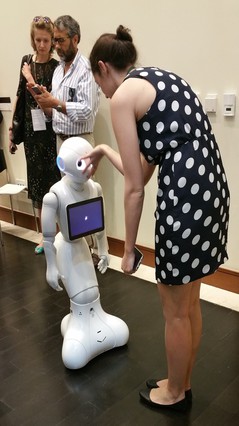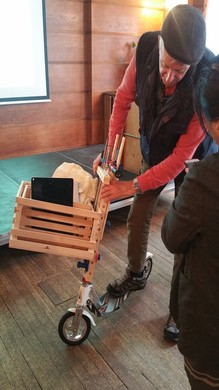Richard's universal robots
 The robot in the video is actually a giant hoist attached to the ceiling. It has big grab bars down at the level of the person sitting on the edge of the bed, waiting. When the bars approach, she grabs them, and lets the robot slowly help her up into a standing position, and then begins to move forward.
The robot in the video is actually a giant hoist attached to the ceiling. It has big grab bars down at the level of the person sitting on the edge of the bed, waiting. When the bars approach, she grabs them, and lets the robot slowly help her up into a standing position, and then begins to move forward.
This is not how any of us imagines a care robot, but I am persuaded this is more like our future than the Synths in 2015's Humans, which are incredibly humanoid (helpfully for casting) but so, so far from anything ready for deployment. This thing, which Praminda Caleb-Solly showed at work in a demonstration video at Tuesday's The Shape of Things conference, is a work in progress. There are still problems, most notably that your average modern-build English home has neither high enough ceilings nor enough lateral space to accommodate it. My bedroom is about the size of the stateroom in the Marx Brothers movie A Night at the Opera; you'd have to put it in the hall and hope the grab bar assembly could reach through the doorway. But still.
As the news keeps reminding us, the the Baby Boomer bulge will soon reach frailty. In industrialized nations, where mobility, social change, and changed expectations have broken up extended families, need will explode. In the next 12 years, Caleb-Solly said, a fifth of people over 80 - 4.8 million people in the UK - will require regular care. Today, the National Health Service is short almost 250,000 staff (a problem Brexit exacerbates wholesale). Somehow, we'll have to find 110,000 people to work in social care in England alone. Technology is one way to help fill that gap. Today, though, 30% of users abandon their assistive technologies; they're difficult to adapt to changing needs, difficult to personalize, and difficult to interact with.
Personally, I am not enthusiastic about having a robot live in my house and report on what I do to social care workers. But I take Caleb-Solly's point when she says, "We need smart solutions that can deal with supporting a healthy lifestyle of quality". That ceiling-hoist robot is part of a modular system that can add functions and facilities as people's needs and capacity change over time.
 In movies and TV shows, robot assistants are humanoids, but that future is too far away to help the onrushing 4.8 million. Today's care-oriented robots have biological, but not human, inspirations: the PARO seal, or Pepper, which Caleb-Solly's lab likes because it's flexible and certified for experiments in people's homes. You may wonder what intelligence, artificial or otherwise, a walker needs, but given sensors and computational power the walker can detect how its user is holding it, how much weight it's bearing, whether the person's balance is changing, and help them navigate. I begin to relax: this sounds reasonable. And then she says, "Information can be conveyed to the carer team to assess whether something changed and they need more help," and I close down with suspicion again. That robot wants to rat me out.
In movies and TV shows, robot assistants are humanoids, but that future is too far away to help the onrushing 4.8 million. Today's care-oriented robots have biological, but not human, inspirations: the PARO seal, or Pepper, which Caleb-Solly's lab likes because it's flexible and certified for experiments in people's homes. You may wonder what intelligence, artificial or otherwise, a walker needs, but given sensors and computational power the walker can detect how its user is holding it, how much weight it's bearing, whether the person's balance is changing, and help them navigate. I begin to relax: this sounds reasonable. And then she says, "Information can be conveyed to the carer team to assess whether something changed and they need more help," and I close down with suspicion again. That robot wants to rat me out.
There's a simple fix for that: assume the person being cared for has priorities and agency of their own, and have the robot alert them to the changes and let them decide what they want to do about it. That approach won't work in all situations; there are real issues surrounding cognitive decline, fear, misplaced pride, and increasing multiple frailties that make self-care a heavy burden. But user-centered design can't merely mean testing the device with real people with actual functional needs; the concept must extend to ownership of data and decision-making. Still, the robot walker in Caleb-Solly's lab taught her how to waltz. That has to count for something.
The project - CHIRON, for Care at Home using Intelligent Robotic Omni-functional Nodes - is a joint effort between Three Sisters Care, Caleb-Solly's lab, and Shadow Robot, and funded with £2 million over two years by Innovate UK.
Shadow Robot was the magnet that brought me here. One of the strangest and most eccentric stories in an already strange and eccentric field, Shadow began circa 1986, when the photographer Richard Greenhill was becalmed on a ship with nothing to do for several weeks but read the manual for the Sinclair ZX 81. His immediate thought: you could control a robot with one of those! His second thought: I will build one.
 By 1997, Greenhill's operation was a band of volunteers meeting every week in a north London house filled with bits of old wire and electronics scrounged from junkyards. By then, Greenhill had most of a hominid with deceptively powerful braided-cloth "air muscles". By my next visit, in 2009, former volunteer Rich Walker had turned Shadow into a company selling a widely respected robot hand, whose customers include NASA, MIT, and Carnegie-Mellon. Improbably, the project begun by the man with no degrees, no funding, and no university affiliation has outlasted numerous more famous efforts filled with degree-bearing researchers who used up their funding, published, and disbanded. And now it's contributing robotics research expertise to CHIRON.
By 1997, Greenhill's operation was a band of volunteers meeting every week in a north London house filled with bits of old wire and electronics scrounged from junkyards. By then, Greenhill had most of a hominid with deceptively powerful braided-cloth "air muscles". By my next visit, in 2009, former volunteer Rich Walker had turned Shadow into a company selling a widely respected robot hand, whose customers include NASA, MIT, and Carnegie-Mellon. Improbably, the project begun by the man with no degrees, no funding, and no university affiliation has outlasted numerous more famous efforts filled with degree-bearing researchers who used up their funding, published, and disbanded. And now it's contributing robotics research expertise to CHIRON.
Seen Tuesday, Greenhill was eagerly outlining a future in which we can all build what we need and everyone can live for free. Well, why not?
Illustrations: Praminda Caleb-Solly presenting on Tuesday (Kois Miah); Pepper; Richard Greenhill demonstrating his personally improved scooter.
Wendy M. Grossman is the 2013 winner of the Enigma Award. Her Web site has an extensive archive of her books, articles, and music, and an archive of earlier columns in this series. Stories about the border wars between cyberspace and real life are posted occasionally during the week at the net.wars Pinboard - or follow on Twitter.